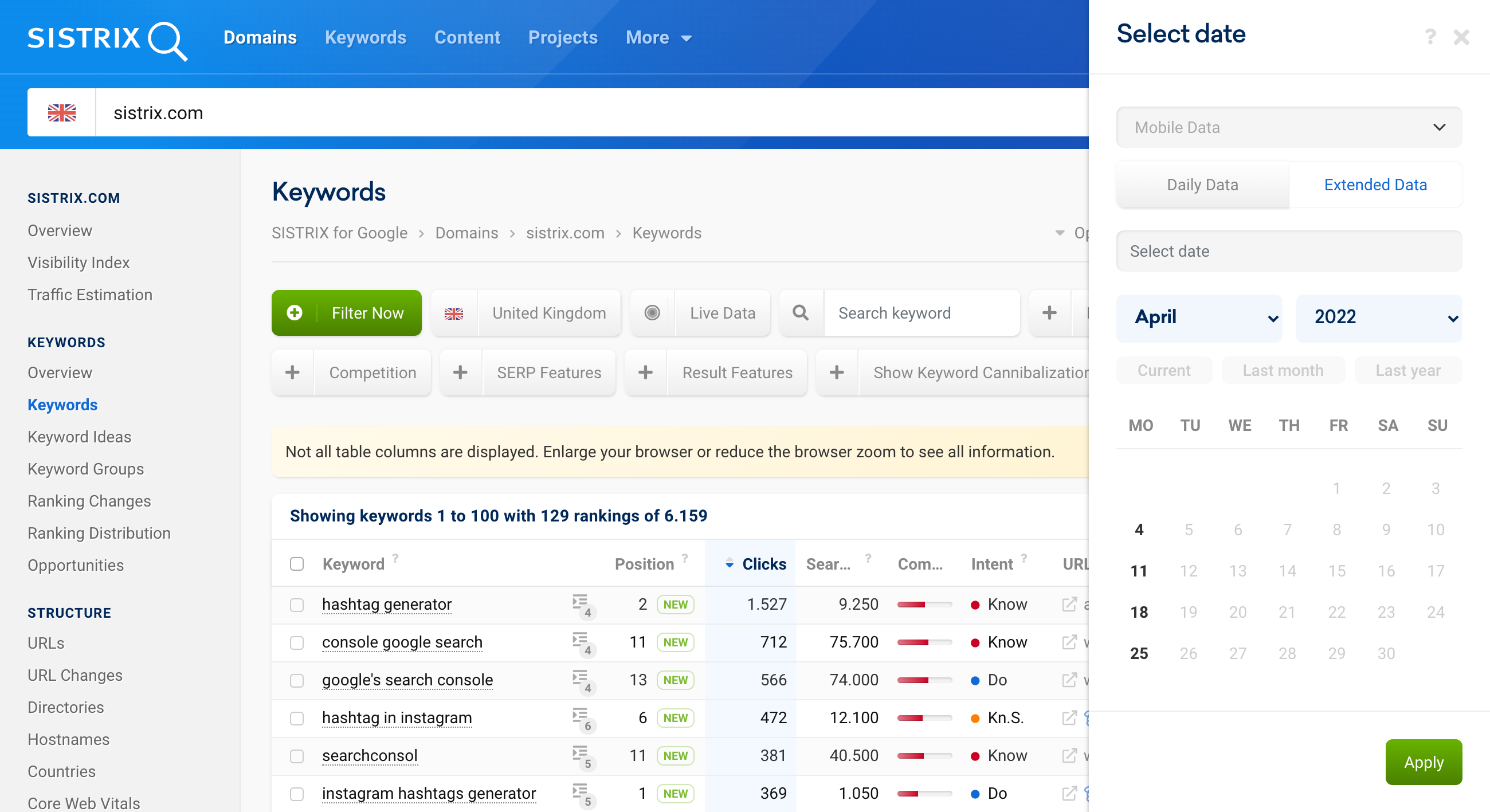In the Toolbox, we offer you several ways to access the mobile ranking data. In order to efficiently use this data, it is helpful to know what those options are, how to select them and what they are best used for.
In addition to the Daily Data (sometimes called historical data), the tool also has the Extended Data (with a monthly update) and since 2022 the Live Data.
To select a different database, you can proceed as follows:
1 Retrieve the data of a domain and select the option Keywords
2 Click on the button Live Data, a menu will open on the right
3 Use the buttons to select Daily Data as well as Extended Data
4 Then select an available day in the calendar
Live Data
We continuously retrieve new rankings for the different databases. Especially for the Live Data, we upload the latest data to the tool every 5 minutes. Therefore, the default view of the keywords always shows you the Live Data and the latest updates at first. You can see that the Live Data is active by the button with the pulsating icon.
The Live Data in the Toolbox:
- consists of rankings of the Daily Data
- also contains rankings of the Extended Data
- The view is updated about every five minutes.
Extended Data
The Extended Data is a database that is continuously updated. Within one month, we renew the ranking data for all keywords in this group. We regularly archive different states of the database. Thus, weekly data points (each with the date of a Monday) are available in the short- to medium-term.
In the long-term, we keep one data point for each month. Thus, the weekly data points contain only a proportional update, while the monthly data points are based on completely new rankings. You can see that a data point is available for a date under “Select date” when the date is marked in bold.
The Extended Data in the Toolbox:
- is based on rankings for 100,000,000 keywords in Germany
- is completely updated once a month
- You can find a data point for every Monday in the tool.
- We archive one data point for every month in the long-term.
Why does the Extended Data show different rankings than the Live Data & the Daily Data?
If you look at the Extended Data, you may often notice that the ranking on one date is different from the ranking for the same keyword in the Live Data or the Daily Data. This is because it takes longer for us to provide a data point for the Extended Data than for the Daily Data. The amount of data for a data point of the Extended Data is much greater than that for one of the Daily Data. Therefore, we start to create the data point several days before.
Consequently, we offer two data points for a domain on a Monday, one for the Daily Data and one for the Extended Data. The daily data point was then created with queries from the last 24h, but the monthly one was already prepared on Thursday or Friday. If we query the keyword again on the weekend, it will already be visible in the Live Data and Daily Data, but not yet in the Extended Data. This will show the update on the following Monday.
Daily Data
The Daily Data is also continuously updated. However, all rankings are renewed after 24 hours here. This database is much smaller than the one of the Extended Data and is also used for the calculation of the Visibility Index.
All results of the daily queries are available here for three months, after which we permanently archive a weekly data point.
The Daily Data in the Toolbox:
- is based on the rankings of 1,000,000 keywords
- The ranking data is updated daily.
- You can find a data point for every day in the tool.
- We archive one data point for each week in the long-term.
Which database is suitable for which purpose?
If you only want to get a quick impression, you can leave the Live Data selected. Although the Extended Data is updated less frequently, it is more widely spread thematically. You are more likely to find rankings for more specific keywords there.
In the Daily Data, you can quickly see short-term changes. This is also true in terms of ranking changes: with the Daily Data you can comprehend changes in the Visibility Index, while the Extended Data is particularly useful for more long-term observations.
